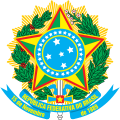You can help expand this article with text translated from the corresponding article in Portuguese. Click [show] for important translation instructions.
|
This list contains national symbols of the Federative Republic of Brazil.
You can help expand this article with text translated from the corresponding article in Portuguese. Click [show] for important translation instructions.
|
This list contains national symbols of the Federative Republic of Brazil.
| Symbol | Name | Image | References |
|---|---|---|---|
| Flag | Flag of Brazil |  | [1] [2] |
| Coat of arms | Coat of arms of Brazil |  | [1] [3] |
| Seal | National Seal of Brazil |  (color) | [1] [4] |
| National motto | "Ordem e Progresso" (lit. 'Order and Progress') | — | [5] |
| National colors | Cores nacionais | Green Yellow "May be used officially alongside": | [1] |
| National anthem | "Hino Nacional Brasileiro"(lit. 'Brazilian National Anthem') |  | [1] [6] |
| National animal | Jaguar |  | |
| National bird | Sabiá-laranjeira (Turdus rufiventris), the rufous-bellied thrush |  | [7] |
| National tree | Pau-brasil (Paubrasilia echinata), the brazilwood |  | [8] |
| National floral emblem | On 27 June 1961, President Janio Quadros issued a Federal Decree declaring the IPÊ-AMARELO as Brazil's National Flower. The term IPÊ-AMARELO specifically refers to the Golden Trumpet Flower, while IPÊ denotes the Trumpet Tree. [a] |  | |
| National founder | Pedro I of Brazil |  |
O centro de interesse para as festividades do 'Dia da Ave' será o Sabiá (Turdus Rufiventris), como símbolo representativo da fauna ornitológica brasileira e considerada popularmente Ave Nacional do Brasil.
É declarada Árvore Nacional a leguminosa denominada Pau-Brasil (Caesalpinia Echinata, Lam)
O ipê é considerado flor nacional por consenso.